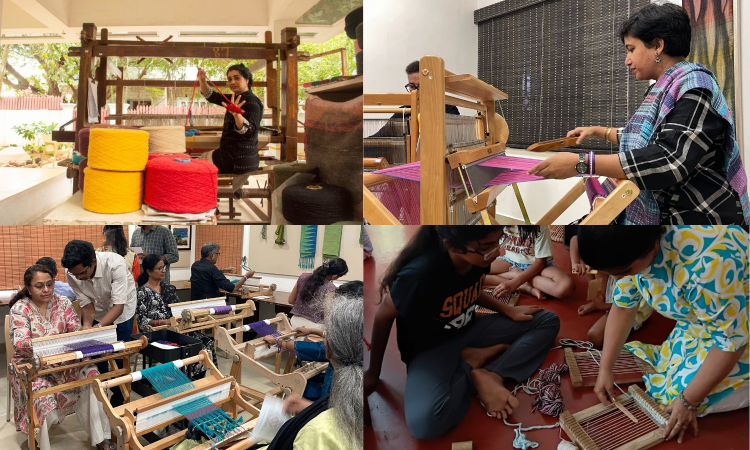Chennai: Handloom weaving finds new life in urban hands
Once seen as a rural, inherited skill, weaving is now finding a new audience in cities. With contemporary studios and community-led initiatives, people are learning the art of weaving for the joy of making

Shuttles & Needles, a contemporary weaving studio located in Adyar
CHENNAI: Handloom has always been a part of our culture. Every year, August 7 is celebrated as National Handloom Day to honour the craft and the people behind it. While many organisations promote handloom in various ways, what truly matters is helping more people understand what weaving is: the time, skill, and heritage that go into each piece. This National Handloom Day, meet the people who are teaching the nuances of weaving to urban audiences. They are not only preserving tradition but also reshaping how we see and value handmade craft.
Shuttles & Needles, a contemporary weaving studio located in Adyar, recently hosted ‘Weaving Mela '25’ to mark the occasion. “The purpose of the event was to showcase the creative side of hand weaving and spread awareness about our rich handloom culture. The workshop was designed for individuals who already weave at home using small looms. This time, we had about 45 participants," says Naresh Ramasubramaniam, founder of the studio.
The theme of the event was the recreation of traditional Indian motifs such as Kancheepuram temple borders, Jamdani designs, thazhampoo rekku, using contemporary looms. “The idea was to show how these traditional motifs can be created on modern, home-based looms. Everyone created their versions of the motifs and took them home,” Naresh explains. “They also got a deeper understanding of how traditional weave structures work in today’s tools. People brought in pieces they had already woven and shared ideas; it became a space for creative exchange and community building.”
While there’s growing interest in supporting handloom from private initiatives and government efforts, much of it focuses on livelihoods and artisan welfare. Naresh, however, believes in a different approach. “Support should come from the right place, not out of sympathy. We see craft not as a symbol, but as a form of knowledge. If we treat it as knowledge, it becomes open and accessible to children, working professionals and anyone. If more people try weaving for themselves, even in a small way, their appreciation for handloom deepens. You don’t have to make a full saree, just weaving something small with your hands can change how you look at the craft," he says.
At Shuttles & Needles, they encourage hands-on engagement. Interestingly, most of their clients are working professionals from non-design backgrounds. “Ninety-five per cent of our clients are working professionals. Many tell us that after learning to weave, they now look at handloom sarees with a whole new respect. Real appreciation comes when you understand the skill behind it. It shouldn’t be about pity, it should be about valuing the real work and knowledge that goes into it," Naresh says.
The studio also works with schools and homeschooling communities, introducing weaving to the younger generation. “We’ve taken weaving into schools. If children learn it now, they’ll preserve it later. We also conduct ‘weave walks’ where we explain different types of weaves, looms, and even the maths and science behind it. Few people realise that the concept of computation goes back to weaving, all the way to 1804. That’s the kind of awareness we’re trying to build.”
Weaver and textile artist Prasida Chavan, based at the Cholamandal Artists’ Village, has been teaching and practising weaving for over 30 years. At her space, she runs regular workshops focused on the basics of weaving, using simple box looms that anyone can learn on. “I teach people how to create interesting patterns and understand techniques such as knotting and shaping. My looms are easy to use, even for beginners,” she says.
She also emphasises sustainability by encouraging participants to repurpose old sarees and dupattas into coasters, mats, wall hangings, and other home products. “Weaving is not just a skill; it’s a way to reuse what we already have. Many people bring old textiles from home and give them new life. Once they learn the basics, I provide them with a loom kit so they can continue weaving at home.”
For many of her students, weaving becomes more than a craft; it becomes therapy. “People tell me it feels like meditation. It calms them down. Some say it helps them reconnect with their creativity. More people should learn weaving. That’s why I started these workshops to help people make beautiful things from what they already have," Prasida adds.



